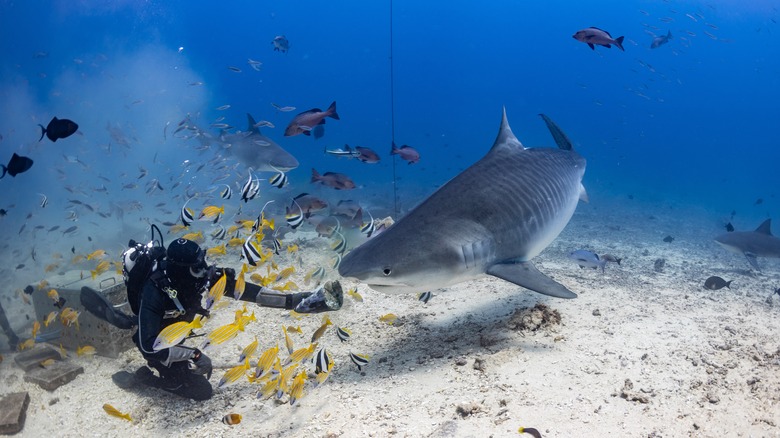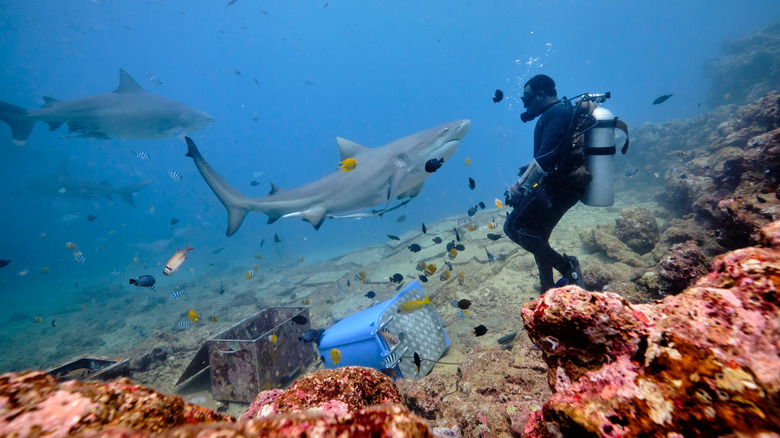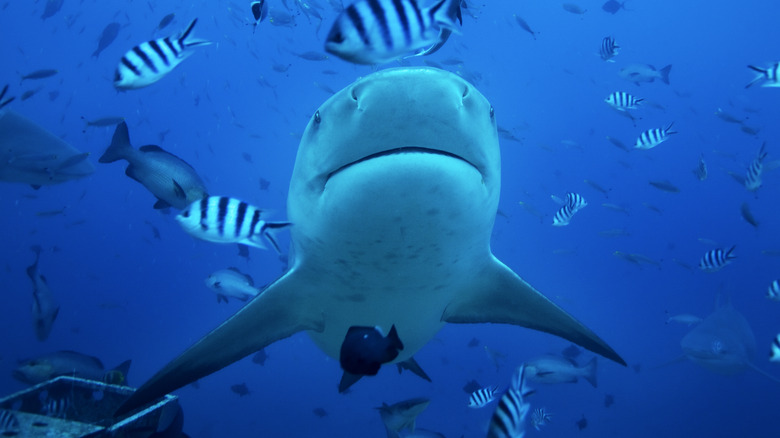This Fiji Island Is An Absolute Must-Visit For Daring Divers
Not everyone can say they would enjoy having a 13-foot tiger shark swimming within a few inches of their face. But if you're one of the rare breeds who gets a rush from viewing these apex predators up close, then Fiji is the perfect place for you. Of the 500 or so shark species that roam the earth's oceans, the Beqa Lagoon is home to eight different species of these beauties: whitetips, blacktips, grey reefs, tawny nurses, sicklefin lemons, silvertips, bulls, and tiger sharks.
There are a few names tossed in there that undoubtedly raise the proverbial eyebrow, even among the gutsiest divers out there. Yet this world-famous shark dive with Beqa Adventure Divers has proven to be a sound conservation strategy and popular tourist attraction. The dive shop established the Shark Reef Marine Reserve in 2004, the first of its kind in the country, swiveling the local economy from shark hunting to shark feeding, creating revenue for the local communities, and teaching tourists about the importance of shark conservation. In this case, it's a win-win for sharks and divers alike.
What to expect on the Fiji shark dive
With its year-round warm waters and close proximity to the Great Astrolabe Reef (one of the largest on the planet), these Fijian waters are positively teeming with life. You'll be spoiled with appearances from critters of every size, shape, and creed, including sea turtles, garden eels, octopuses, and some of the 450 species of fish that call this region home, from sleek barracudas to vibrant lionfish. In no uncertain terms, it's a feast for the eyes.
The site for swimming with sharks is known as the Cathedral, ranging in depth from 15 feet to 100 feet. When you get there, you'll descend down a stone wall and head to the lowest point first. On the seafloor, you'll kneel behind a rock wall and form part of a "human chain" of 20 people. Your guides will bait the sharks with tuna from an underwater bin, at times feeding them with their hands. Though the baiting practice is viewed as controversial among marine experts, it has helped populate the area with diverse species and contributed to higher fishing yields for nearby villages. The team prioritizes safety and conservation at the heart of everything they do.
With the feeding frenzy underway, each dive attracts somewhere between 10 to 30 bull sharks, though up to 100 have joined the party in the past. Tiger sharks tend to be more solitary animals, but you're likely to spot two to three while you're down there. As you ascend back toward the boat, you'll be greeted by blacktips and whitetips, who have been known to come right up to divers to say hello. It's not every day you can lock eyes with a true king (or queen) of the sea.
Safety protocols and tips for visiting
Before you book your vacation to Fiji, there are few talking points. For obvious reasons — namely, these are fierce predators we're talking about — the dive with Beqa Adventure Divers is highly regulated. You won't be allowed to explore the dive site on your own, as the guides will be guarding the "human chain" on all sides with metal staffs, in case a shark decides to get too close. It's also required that you have your advanced open water dive certificate. If you have less than 30 dives under your belt, you'll need to hire a divemaster for extra supervision. You can always brush up on your dive skills at the team's dive shop in Pacific Harbour.
Each tour costs $213 and includes two dives on the same day, an hour break for refreshments, and hot showers to decompress. Should you feel called to explore the area a little more, you can always add on a coral reef and shipwreck tour for an additional $202. The best time to visit for optimal visibility is the dry season, which is considered May through October. If you're up for the adrenaline rush, the shark dive is easily one of the best things to do in Fiji.


